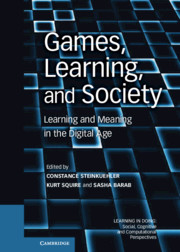Book contents
- Frontmatter
- Contents
- Contributors
- Series Foreword
- Foreword
- Acknowledgments
- Section I Games as Designed Experience
- Section II Games as Emergent Culture
- Section III Games as Twenty-First-Century Curriculum
- 17 Introduction to Section III
- 18 Prediction and Explanation as Design Mechanics in Conceptually Integrated Digital Games to Help Players Articulate the Tacit Understandings They Build through Game Play
- 19 Game-Based Curricula, Personal Engagement, and the Modern Prometheus Design Project
- 20 Discovering Familiar Places
- 21 Developing Gaming Fluencies with Scratch
- 22 “Freakin’ Hard”
- 23 Models of Situated Action
- Afterword Games and the Future of Education Research
- Index
- References
21 - Developing Gaming Fluencies with Scratch
Realizing Game Design as an Artistic Process
Published online by Cambridge University Press: 05 August 2012
- Frontmatter
- Contents
- Contributors
- Series Foreword
- Foreword
- Acknowledgments
- Section I Games as Designed Experience
- Section II Games as Emergent Culture
- Section III Games as Twenty-First-Century Curriculum
- 17 Introduction to Section III
- 18 Prediction and Explanation as Design Mechanics in Conceptually Integrated Digital Games to Help Players Articulate the Tacit Understandings They Build through Game Play
- 19 Game-Based Curricula, Personal Engagement, and the Modern Prometheus Design Project
- 20 Discovering Familiar Places
- 21 Developing Gaming Fluencies with Scratch
- 22 “Freakin’ Hard”
- 23 Models of Situated Action
- Afterword Games and the Future of Education Research
- Index
- References
Summary
Much of the current games research focuses on how learning to play games can engage players in various valuable practices relevant to and supportive of school learning and literacies (see Gee, 2003). We contend that learning to design games can engage youth in an equally wide range of valuable practices, all of which are complexly intertwined ecologies that help youth to coordinate multiple activities and types of meaning-making systems (Kafai, 2006a). We call this intermix of technology and gaming practices gaming fluencies because youth can become fluent not only in game design but also in the creative, critical, and technical aspects of working with new media. We’re using game production as a way to promote gaming literacy in the broadest sense as well as to enhance technology fluency, particularly among disadvantaged youth (Kafai, Peppler, & Chiu, 2007). Our approach of gaming fluencies aligns with work in the constructionist tradition (Kafai, 2006b; Papert, 1980) that proposes pedagogies to promote technology fluency and further argues that video games are a form of twenty-first-century art (Mitchell & Clarke, 2003).
To illustrate our view on gaming fluencies, we examine the game artifacts that were designed in a place called the Computer Clubhouse, a community technology center located in South Los Angeles (Kafai, Peppler, & Chapman, 2009). Youth in this clubhouse had access to a wide range of design tools, but our attention focuses particularly on their use of Scratch (Resnick et al., 2009), a media-rich software design environment that we introduced beginning in 2005 as part of a larger research project. During the following two years, we documented daily design work in field notes and archived all Scratch projects. Our analyses will focus on an archive of Scratch projects created over a two-year period by clubhouse members. A large percentage of these designs were games that imitated standard game genres or were interactive narratives and are the subject of this chapter (more than 68 percent of the total archive, n = 430) (Peppler & Kafai, 2010). Scratch games were categorized in a wide range of genres, including sports, adventure, and racing games, but also included mazes or puzzles.
- Type
- Chapter
- Information
- Games, Learning, and SocietyLearning and Meaning in the Digital Age, pp. 355 - 380Publisher: Cambridge University PressPrint publication year: 2012
References
- 13
- Cited by



